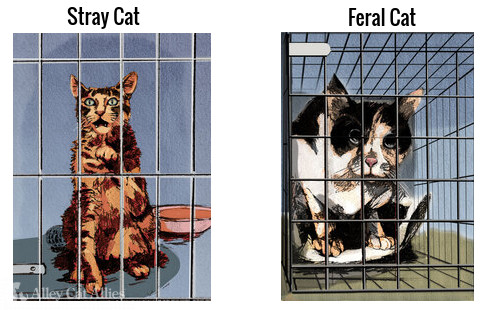Quick Facts:
- Street Cat is a broad term encompassing any unowned domestic cat living outdoors. This includes both feral and stray cats.
- Street cats exhibit diverse behaviors and levels of socialization. Refer to the Cat Socialization Continuum guide for detailed information.
- Observing a street cat’s body language and behavior is key to assessing their socialization level.
- Knowing a street cat’s socialization level helps determine the best course of action for their well-being.
- Trap-Neuter-Return (TNR) is beneficial for all street cats, regardless of their socialization.
Domestic cats living outdoors, often referred to as street cats, come in different forms, each with unique behaviors and levels of interaction with humans. While they are all Felis catus, just like pet cats living indoors, understanding the nuances between stray and feral street cats is crucial.
Whether you’re a veterinarian, animal rescuer, or simply someone who cares about the street cats in your neighborhood, knowing how to distinguish between them will inform your interactions and help you decide on the most appropriate course of action for each cat’s welfare.
What Does Socialization Mean for a Cat?
In cat behavior, “socialization” refers to a cat’s comfort and positive association with human companionship. A socialized cat is accustomed to and enjoys being around people. Socializing a cat involves acclimating it to human touch, environments, sights, smells, and sounds. This is a gradual process influenced by various factors in a cat’s life, requiring patience and care from humans.
Kittens undergo socialization primarily through interaction with humans—being held, spoken to gently, and played with—especially during their early weeks. If a kitten misses this critical socialization window, they are likely to develop a fear of humans, making them unsuitable and unhappy as indoor pets. Therefore, early socialization, including exposure to different people and animals, is vital for a kitten’s balanced development.
Stray Cat vs. Feral Cat: Key Differences in Street Cats
While both stray and feral cats fall under the umbrella term “street cat,” there are fundamental differences rooted in their socialization levels. Pet cats and stray cats share a commonality: they have been socialized to humans at some point in their lives.
Feral cats, on the other hand, are not socialized to people. Although they form social bonds with other cats and their feline families, they lack that bond with humans.
Community Cats: An Overview of Street Cats
“Community cat” is a broad term encompassing any un-owned Felis catus living outdoors. Both feral and stray cats are considered community cats or street cats. These cats exhibit a spectrum of behaviors and socialization levels but generally prefer outdoor living and are not typically adoptable into indoor homes.
Stray Cats: Formerly Socialized Street Cats
- A stray cat is a street cat that once lived indoors and was socialized to humans but has become lost, abandoned, or left their home and no longer has regular human interaction.
- Over time, a stray cat can revert towards a feral state if human contact diminishes significantly.
- A stray cat might still be socialized enough to tolerate human touch initially, but this sociability decreases without consistent positive human interaction.
- Under favorable conditions, a stray cat can transition back to being a pet cat. However, re-introducing stray cats to indoor living after an extended period outdoors may require a period of adjustment as they might be fearful and cautious initially.
Feral Cats: Unsocialized Street Cats
- A feral cat is an unsocialized street cat that has either never had physical contact with humans or whose human contact has significantly decreased over time to the point of being no longer accustomed to it. Most feral cats are afraid of people and are unlikely to ever become comfortable as lap cats or indoor pets.
- Kittens born to feral street cats can be socialized if handled early in life and can be adopted into homes.
- Generally, socializing feral kittens older than 4 months is not recommended by organizations like Alley Cat Allies. Socializing older feral kittens is time-intensive, and successful outcomes are not guaranteed.
Why Distinguishing Street Cats Matters
Understanding the varying degrees of socialization in street cats is crucial for determining the most appropriate care and protection strategies. Resources like “The Cat Socialization Continuum: A Guide to Interactions Between Cats and Humans” offer detailed insights into this spectrum.
- Stray cats, due to their previous socialization, have the potential to readjust to living with people and can be good candidates for adoption into indoor homes if resources and time are available for fostering and acclimation.
- Differentiating between stray and feral street cats can be challenging, particularly when they are stressed or trapped. Scared stray cats often need time to de-stress to accurately assess their socialization level.
- Adult feral street cats, being unsocialized, are not suited for indoor living. If taken to shelters, they are often euthanized due to their unsocialized nature. Therefore, it is generally in their best interest to remain in their outdoor environment.
- Trap-Neuter-Return (TNR) programs are vital for street cats. TNR benefits all community cats, regardless of socialization. Through TNR, street cats are humanely trapped, checked for microchips, spayed/neutered, vaccinated, ear-tipped for identification, and microchipped if needed. Stray cats who are healthy and without microchips can be returned to their outdoor homes or placed in foster care for potential adoption.
Identifying Street Cats Outdoors: Stray or Feral?
Determining a street cat’s socialization level can be difficult, especially during stressful situations like trapping. Observing their behavior in their natural outdoor environment is more reliable.
NOTE: The Socialization Continuum is varied. Street cats may not fit neatly into either stray or feral categories. Refer to the Socialization Continuum guide for a comprehensive understanding of possible variations.
Socialization Towards Humans
Stray Street Cats: May approach people, houses, porches, or vehicles.
Feral Street Cats: Will avoid human approach and seek hiding places.
Socialization Towards Other Cats
Stray Street Cats: Likely to live alone, not typically part of a group or colony.
Feral Street Cats: May live in colonies or groups.
Body Language Cues
Stray Street Cats: Might exhibit body language similar to a house cat, such as walking with tail raised—a sign of friendliness. Likely to make eye contact, blink, or look at you.
Feral Street Cats: May crawl, crouch low to the ground, and protect their body, tail tucked. Unlikely to make eye contact.
Vocalization Patterns
Stray Street Cats: May be vocal, meowing or “answering” human voices.
Feral Street Cats: Typically silent, won’t meow, beg, or purr.
Activity Schedule
Stray Street Cats: More often seen during daylight hours.
Feral Street Cats: Primarily nocturnal, occasionally active during the day.
Physical Appearance Clues
Stray Street Cats: May appear dirty or unkempt and will not have an ear tip (a universal sign of being part of a TNR program).
Feral Street Cats: Usually have a cleaner, well-maintained coat. Unneutered males may have a larger head, thicker neck, muscular build, and scars from fights. They might also have a spiky coat from higher testosterone, less grooming, or “stud tail”—hair loss or greasiness at the tail base due to hormones. A feral cat who has been through TNR will likely have an ear tip.
Pregnancy, Nursing, and Kittens
Feral Street Cats: Female street cats who are pregnant or nursing are more likely to be feral, as fewer feral cats are spayed compared to pet cats.
Important Consideration: Socialization in street cats is not always clear-cut, especially for community cats who recognize their caregivers. They may show familiarity signs like an upright tail or staying on a caregiver’s porch, developed over time through interaction with a specific person. However, these behaviors don’t automatically mean the cat is suited for indoor living.
Distinguishing Feral and Stray Street Cats Post-Trapping
In stressful environments like a trap or shelter, even a friendly stray street cat may behave like a feral cat, avoiding contact and potentially showing aggression out of fear. The unfamiliar surroundings can be highly unsettling for them.
Here’s how to differentiate a feral cat from a frightened stray cat in confinement or unfamiliar settings:
Touch Tolerance
Stray Street Cats: May eventually allow some level of touch, possibly tolerating brief petting with an object.
Feral Street Cats: Remain untouchable, even by caregivers.
Behavior in a Cage
[ Stray and Feral Cats Caged](Stray and Feral Cats in Cages)
Stray and Feral Cats Caged](Stray and Feral Cats in Cages)
Stray Street Cats: May approach the front of the cage and might eventually rub against it in a friendly manner.
Feral Street Cats: Will likely stay at the back of the cage, retreating as far as possible. If startled, they may shake, rattle the cage, or injure themselves by banging against it.
Relaxation Over Time
Stray Street Cats: May show signs of relaxation over time in captivity.
Feral Street Cats: Remain consistently tense and unsocial, not relaxing even with time.
Responsiveness to Stimuli
Stray Street Cats: Might show interest in toys or food placed near the cage. May respond to familiar household sounds like food cans or bags opening.
Feral Street Cats: Likely to ignore people, toys, and possibly even food. Show no recognition or interest in household sounds.
Fear and Anxiety Indicators
[ Stray and Feral Cats Fear and Anxiety](Stray and Feral Cats Showing Fear and Anxiety)
Stray and Feral Cats Fear and Anxiety](Stray and Feral Cats Showing Fear and Anxiety)
Stray Street Cats: May hiss or growl as expressions of anxiety.
Feral Street Cats: Will become aggressive and lash out if feeling threatened or cornered. Aggression signs include flattened ears and dilated pupils.
Next Steps After Identification
Ensure you have gathered sufficient information to accurately assess the street cat’s socialization level. Once you have a good understanding, the immediate next step is to get the cat neutered or spayed. Following this, use your assessment to determine the best course of action for the cat, which might include:
Founded in 1990, Alley Cat Allies is a leading advocacy organization dedicated to protecting and improving the lives of all cats. With over 1.5 million supporters, they advocate for humane and effective community programs and policies for cats. Through advocacy, care, education, and policy activism, they empower communities to adopt non-lethal, evidence-based approaches to cat welfare. Visit www.alleycat.org for more information. They are also active on social media platforms like Facebook, X (Twitter), Instagram, LinkedIn and YouTube. Charlene Pedrolie is the President and COO of Alley Cat Allies.
